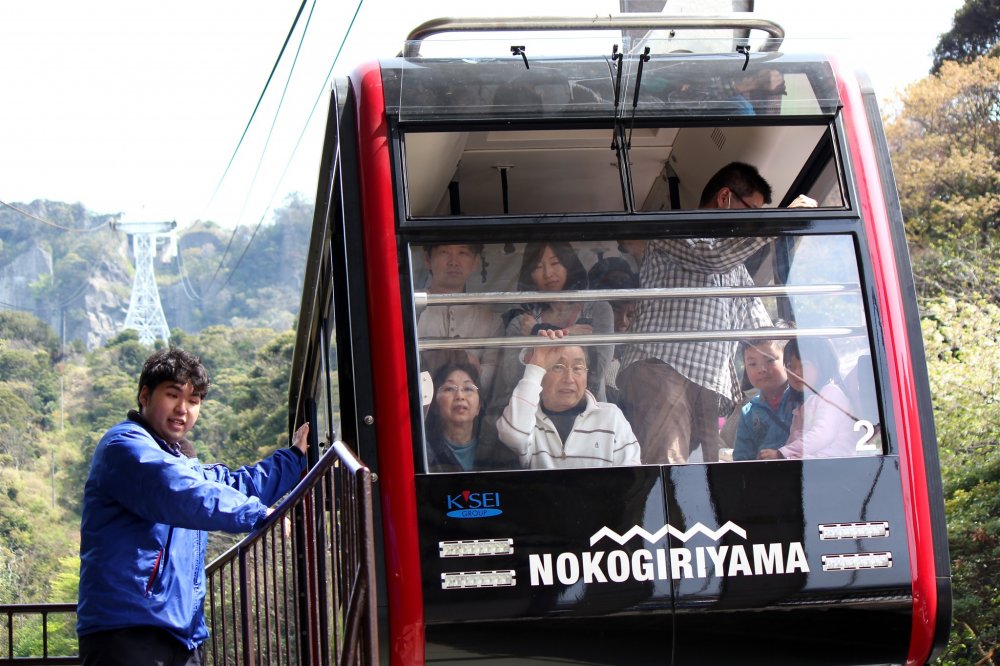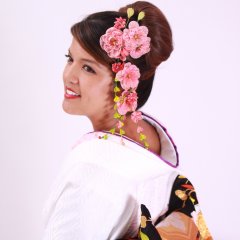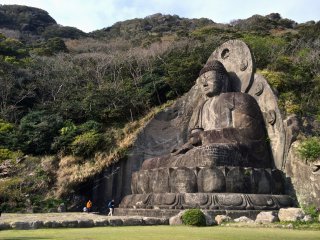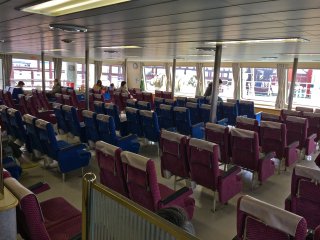
Mt Nokogiriyama or "Sawtooth Mountain" acquired its distinctive profile from its history as a stone quarry during the Edo Period. Pictured here is Hyakusyaku Kannon and famous cliff, Jigokunozoki(地獄覗き), which literary means "hell watch stand."

The Nokogiriyama Ropeway is open daily from 9:00am - 5:00pm (weather permitting). Adults 500 yen one-way, 930 yen roundtrip; Children (ages 5-11) are half price.
![Nihonji Daibutsu stands 31-meter-tall and is an image of Yakushi Nyorai, the Buddha of healing and medicine. It was created in the late 1700s by master artisan Jingoro Eisei Ono and his many apprentices.]()
Nihonji Daibutsu stands 31-meter-tall and is an image of Yakushi Nyorai, the Buddha of healing and medicine. It was created in the late 1700s by master artisan Jingoro Eisei Ono and his many apprentices.
![The interior view of the Tokyo Wan Ferry from the Kurihama Ferry Terminal in Kanagawa.]()
The interior view of the Tokyo Wan Ferry from the Kurihama Ferry Terminal in Kanagawa.
![Just a 40-minute cruise from Kurihama Port Terminal, on a clear day you can view Mt Nokogiriyama from the comfort of the ferry.]()
Just a 40-minute cruise from Kurihama Port Terminal, on a clear day you can view Mt Nokogiriyama from the comfort of the ferry.
![At 329 meters high, Mt Nokogiriyama offers breathtaking views of Tokyo Bay and rolling green hills of Boso Peninsula.]()
At 329 meters high, Mt Nokogiriyama offers breathtaking views of Tokyo Bay and rolling green hills of Boso Peninsula.
![Hyakusyaku Kannon or Hundred Shaku Kannon was carved in 1963 as a memorial and prayer for victims of World War II.]()
Hyakusyaku Kannon or Hundred Shaku Kannon was carved in 1963 as a memorial and prayer for victims of World War II.
![Standing below the chiseled mountain cliff offers a different perspective of Jigokunozoki. Let's go!]()
Standing below the chiseled mountain cliff offers a different perspective of Jigokunozoki. Let's go!
![Ask someone to stay behind at the Ruriko Observatory to take your picture standing on the steep cliff named Jigokunozoki also known as "hell watch stand."]()
Ask someone to stay behind at the Ruriko Observatory to take your picture standing on the steep cliff named Jigokunozoki also known as "hell watch stand."
![It is said there are 2,000 steps that run across Mt Nokogiriyama. I never counted, but it certainly felt like thousands!]()
It is said there are 2,000 steps that run across Mt Nokogiriyama. I never counted, but it certainly felt like thousands!
![En route to the 1,500 stone figures of Tokai Arhats takes you across this cute footbridge.]()
En route to the 1,500 stone figures of Tokai Arhats takes you across this cute footbridge.
![Main entrance to view the 1,500 stone images of Arhats carved by Jingoro Eirei Ono, a master artisan, and his 27 apprentices.]()
Main entrance to view the 1,500 stone images of Arhats carved by Jingoro Eirei Ono, a master artisan, and his 27 apprentices.
![This collection of carved Arhats are great treasures of the temple and valuable cultural assets.]()
This collection of carved Arhats are great treasures of the temple and valuable cultural assets.
![The 1,500 stone figures of Tokai Arhats were chiseled from special stones brought in from Izu by the sea. Each are marvelous masterpieces depicting the spirit of eternal benevolence.]()
The 1,500 stone figures of Tokai Arhats were chiseled from special stones brought in from Izu by the sea. Each are marvelous masterpieces depicting the spirit of eternal benevolence.
![Most of the pathways are never-ending staircases, but you'll eventually run into some natural terrain such as this along the way. Be sure to wear comfortable hiking shoes!]()
Most of the pathways are never-ending staircases, but you'll eventually run into some natural terrain such as this along the way. Be sure to wear comfortable hiking shoes!
![2,000 steps, natural pathways and low hanging cliffs over-head make for an interesting hike throughout Mt Nokogiriyama.]()
2,000 steps, natural pathways and low hanging cliffs over-head make for an interesting hike throughout Mt Nokogiriyama.
![Here's the approach to Nihonji Daibutsu. From the Nokogiriyama Ropeway, the hike will take approximately 60-minutes.]()
Here's the approach to Nihonji Daibutsu. From the Nokogiriyama Ropeway, the hike will take approximately 60-minutes.
![The 31-meter-tall seated image of Yakushi Nyorai, the Buddha of healing and medicine, was created in the late 1700s by master artisan Jingoro Eisei Ono and his many apprentices.]()
The 31-meter-tall seated image of Yakushi Nyorai, the Buddha of healing and medicine, was created in the late 1700s by master artisan Jingoro Eisei Ono and his many apprentices.
![At Nihonji Temple you can find Jizō to answer the prayers of the living for health, success, children, and all manner of mundane petitions. In modern Japan, Jizō is a friend to all, never frightening even to children.]()
At Nihonji Temple you can find Jizō to answer the prayers of the living for health, success, children, and all manner of mundane petitions. In modern Japan, Jizō is a friend to all, never frightening even to children.




































































How many people get into one cable car? I see on your picture, there're people who stand inside the cable car